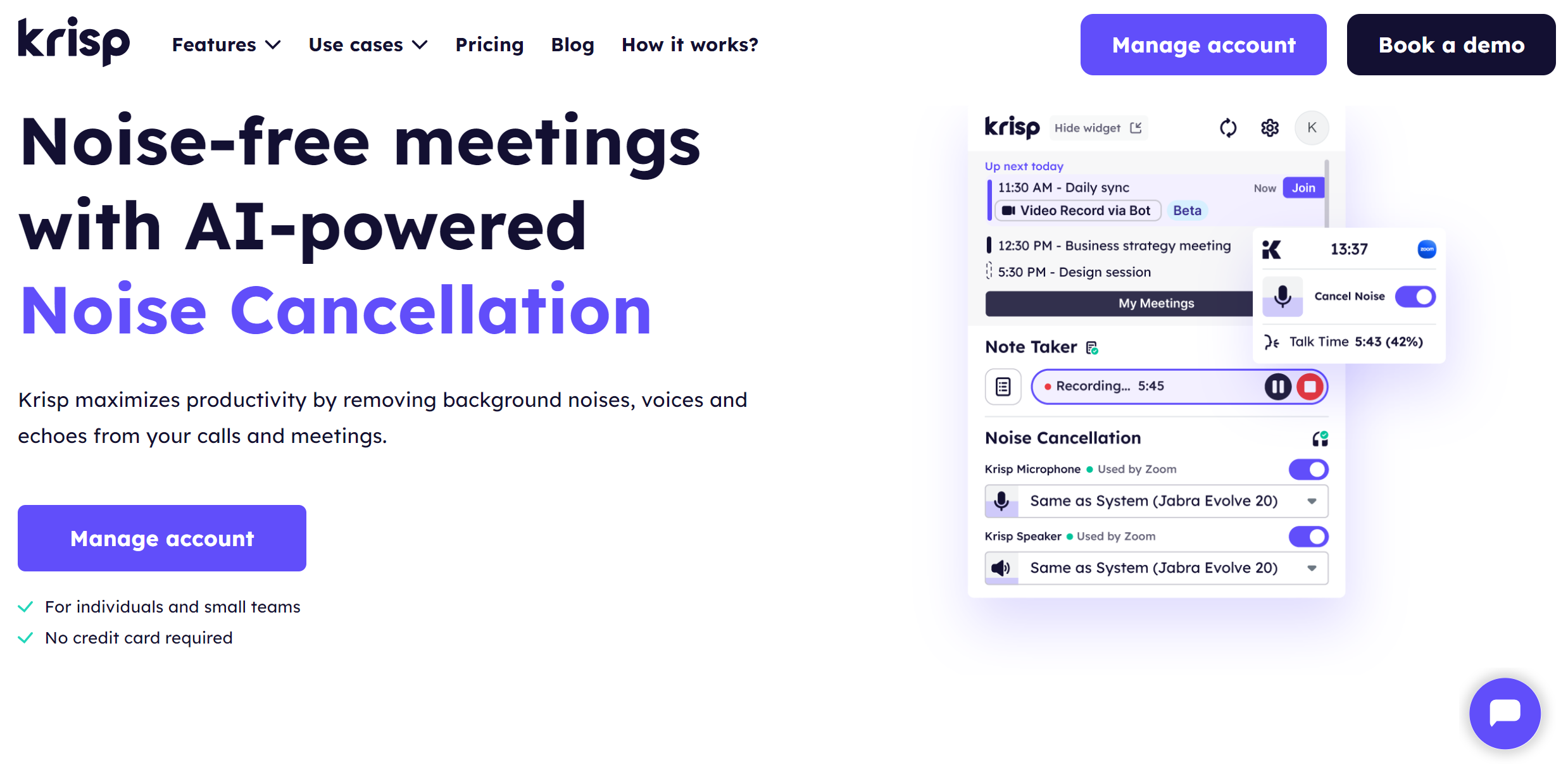- Knowing how to soundproof a room will keep you away from unwanted noise both offline and online.
- Learning how to make a room soundproof for maximum efficiency can create a haven of tranquility.
- An AI Noise Cancellation App that serves as an addition to soundproofing cost-effectively and hassle-free. Specifically, it prevents disruptive sounds from reaching online meeting participants.
Sound vibrations affect us physiologically, neurologically, and biochemically. Precisely, sounds influence our health and well-being. We react to them positively or negatively. How to soundproof a room from the noise that constantly disrupts your peace and productivity?
This article explains how to create a quiet sanctuary to block traffic noise or household sounds through practical and effective techniques. Importantly, it unveils an AI Noise Cancellation Assistant, a leader in real-time Voice AI, that serves as a soundproofing addition to increasing productivity during online interactions.
Sound, Music, and Noise

Did you know normal human ears are sensitive to frequencies between 20 and 20,000 Hz? But our hearing isn’t limited to this: all detectable sounds can be interpreted into musical “frequency zones” with their “feels.” That’s why knowing how to soundproof a room is more vital than you might think.
What makes sound, music, and noise different?
Sound
Sound is an energy type that vibrations make. “We live surrounded by vibrations that are extremely important in how we perceive the world,” says neuroscientist Daniel Huber. Haven’t you ever listened to the rain and automatically felt a sense of calm?
So, it’s no surprise that sounds are contributing to the future of telecoms. Thanks to sounds, humans and other animals can communicate and understand one another using the pitch of their voice or accent.
Moreover, Brain-Computer Interfaces (BCIs), as a bridge between your brain and an external device, enable interaction with machines. Increasingly, they improve object control by translating the user’s brain activity into commands. Thus, BCIs promise to revolutionize the future of work.
Music
Music psychologically affects our emotions. Researchers have revealed that listening to enjoyable music releases dopamine in our brains. Dopamine is a chemical that gives us feelings of pleasure, satisfaction, and motivation.
For example, according to Oliver Sacks, one of the best-known neurologists, music elicits “emotions and associations that had been long forgotten, giving the patient access once again to mood and memories, thoughts and worlds that had seemingly been completely lost.” That’s why patients become unchained by melody.
Conversely, disruptive background noises negatively affect our feelings and emotions. And this once again highlights the importance of knowing how to soundproof a room by canceling noise.
Noise
The term “noise” has different usages, such as sounds at deafening levels and unwanted sounds. According to the Merriam-Webster dictionary, noise means sound, especially one “that lacks an agreeable quality or is noticeably unpleasant or loud.”
According to Hans Ising and Bernd Kruppa, scientists specializing in environmental health, noise can be a non-specific biological stressor. The latter can elicit reactions that prepare the body for fight or flight.
For example, high levels of noise and sounds immensely affect our physical and mental health. Specifically, they can cause hearing loss and reduced well-being, as the National Library of Medicine states.
Before Learning How to Soundproof a Room: Identifying the Source of Noise
Interested in “How do you soundproof a room so others can’t hear?” First, identify the type of noise you’re dealing with.
- Noise Can Be Airborne: It travels through the air and refers to sounds like voices, music, and traffic. For instance, noise from your neighbors chatting or cars honking outside is airborne.
- Impact Noise: This type of noise happens when objects collide, causing vibrations to travel through floors and walls, unlike airborne noise. For example, impact noise comes from someone walking heavily or dropping something upstairs. It can be disruptive, especially in multi-story buildings.
Knowing the difference between noise types helps you pick the proper soundproofing techniques for your space. These techniques can include blocking footsteps from the apartment above or a chair scraping the floor.
Most Common Soundproofing Materials or Methods

Soundproofing doesn’t let sound enter or leave a space. For instance, adding mass-loaded vinyl to walls prevents noise from seeping into a room.
You may ask, “What’s the difference between soundproofing and sound-absorbing?” The latter reduces echo to improve sound quality in a room. Acoustic panels or foam, for example, help absorb sound waves, making a recording studio or home theater clearer and less reverberant.
So, soundproofing keeps noise in or out, while sound-absorbing enhances the sound environment inside a room.
Now, let’s discuss the best materials to block sound.
What Is the Best Material to Block Sound?
Creating a quiet space involves using various soundproofing methods. For instance, you can choose an AI Meeting Assistant for Noise Cancellation or equipment, such as acoustic panels and noise-canceling headphones.
Let’s discuss how to soundproof a room using different materials and techniques to block noise.
Gaps and Cracks
Noise loves to sneak in through tiny gaps around doors and windows. So, use weatherstripping tape to seal these gaps. Moreover, you can apply acoustic caulk to larger cracks because it’s flexible and easy to fix.
Acoustic Panels
Acoustic panels are foam or fabric-covered boards that absorb sound waves and reduce echoes. Consider mounting them on walls to reduce echoes and airborne noise, especially in a recording studio, home theater, or living room.
Dense Walls
Heavier walls more successfully prevent sound transmission. So, consider adding mass by installing mass-loaded vinyl (MLV) sheets or extra drywall layers. Applying MLV behind drywall can be one of the best answers to the question, “How to soundproof a room?”
Carpets and Rugs
Hard floors can make the noise worse. Thankfully, you can absorb unwanted sounds by adding thick carpets or area rugs. Additionally, you can lay down carpets or area rugs to absorb impact noise. Add dense underlays beneath them for better results.
Soundproof Doors
Standard doors often lack soundproofing qualities. So, replacing them with solid-core doors will enhance the soundproofing effect because they’re denser. Moreover, adding a door sweep can help seal the gap at the bottom of the door.
Decoupled Walls and Ceilings
Decoupling creates a gap between surfaces to stop sound vibrations from passing through. So, using resilient channels or sound isolation clips can help separate drywall from wall studs, serving as another great answer to the question, “How to soundproof a room?” This method is more involved but effectively reduces airborne and impact noise.
Soundproof Curtains
Heavy, dense curtains can help block a surprising amount of noise. So, use them over windows and doorways to dampen external sounds. These curtains are especially useful in bedrooms and living rooms.
How to Make a Room Soundproof from Traffic Noise

Even traffic noise with moderate sound pressure levels (SPLs) affects us negatively. According to researchers Asakura and Tsujimura, household sounds, such as those with much lower SPLs than road traffic noise, can affect cognitive performance. The sound pressure level parameter represents how loud a speaker is.
Learning how to soundproof a room can start by:
- Using weatherstripping or acoustic caulk to seal gaps around windows and doors
- Installing double-glazed windows, window films, or window inserts for better sound insulation
- Using heavy soundproof curtains to absorb sound waves before they enter a room
- Adding acoustic panels to walls to absorb unwanted sounds
- Placing thick rugs or carpets on floors can help effectively absorb sound waves and reduce noise levels.
How to Soundproof a Room from Noisy Neighbors
Now, let’s see how to soundproof a room in an apartment from noisy neighbors. Did you know background noises, including chewing sounds, decrease learning efficiency, and quiet environments increase it?
To soundproof your room:
- Use weatherstripping to seal gaps surrounding doors and windows.
- Add heavy curtains to windows to block noise.
- Use rugs or carpets to absorb sound.
- Place bookshelves against shared walls for extra insulation.
- Add a stud wall against a party wall to create a small void to reduce sound.
- Install acoustic panels on the walls to further reduce noise.
- Consider a double-skin of brick with an internal cavity void injected with polystyrene insulation to reduce the noise through the party wall.
How to Soundproof Your Bedroom
What about soundproofing your bedroom?
- Add thick, heavy curtains for your windows to block outside noise
- Use weatherstripping to seal the gaps around windows and doors so sound can’t sneak in
- Place a plush rug or carpet on the floor to absorb sound
- Add some throw pillows or wall tapestries to soften echoes.
- Use acoustic panels for walls to dampen sound
- Consider placing a large bookshelf against a shared wall to reduce noise from the neighboring apartment.
How to Soundproof Ceilings and Floors
To soundproof ceilings:
- Install acoustic panels or a drop ceiling with sound-absorbing tiles to reduce noise from upstairs neighbors.
To soundproof floors:
- Use thick carpets or rugs to absorb sound.
- Add a dense underlay beneath the carpet to minimize noise from the floor below.
- Install mass-loaded vinyl (MLV) under floorboards or use rubber floor mats to improve the quietness of your space.
Can You Soundproof Existing Walls?
Learning how to soundproof a room also means knowing how to soundproof the existing walls.
- Seal any gaps or cracks with acoustic caulk to block sound leaks.
- Add a layer of mass-loaded vinyl (MLV) behind the drywall to reduce noise transmission.
- Hang heavy tapestries or blankets on the walls.
- Use furniture against adjoining walls, such as built-in bookshelves filled with books, to dampen noise from the neighboring apartment.
- Consider installing acoustic panels, which are both practical and decorative.
How to Soundproof a Room for Music
Soundproofing a room for music requires taking several practical steps:
- First, consider installing acoustic panels on the walls. For instance, guitarists often use panels for sound clarity. This option can cost around $30 each.
- Second, add mass to the walls with mass-loaded vinyl (MLV). For example, drummers often opt for this option, which can cost about $2-$5 per square foot.
- Finally, use thick rugs or carpets on the floor. For instance, singers often prefer this studio option to absorb sound and reduce echo.
How Much Does It Cost to Soundproof a Room?
Learning how to soundproof a room also means knowing how much you’ll spend. The cost of soundproofing varies depending on the methods and materials used.
- Sealing gaps with weatherstripping and acoustic caulk, which might cost around $20-$50, is a budget-friendly option.
- Besides, you can add heavy curtains to windows, ranging from $30 to $100.
- Moreover, you may opt for acoustic panels, which cost about $20-$50 per panel. A typical room might need at least eight to ten panels.
- Mass-loaded vinyl might cost about $2-$5 per square foot.
- Acoustic panels and weatherstripping cost around $300 in total.
- High-end professional soundproofing can exceed $1,000. It can include flat or curved acoustic panels, ceiling tiles, diffusers, doors, and soundproof windows designed to provide privacy and harmonic accuracy.
When discussing how to soundproof a room, you may also wonder, “What is the cheapest way to soundproof a wall?” The most cost-effective way is to use effective, budget-friendly materials.
- Consider weatherstripping tape or acoustic caulk to seal gaps and cracks: this can cost around $10-$20
- Hang thick blankets or quilts on the walls: these options are under $30.
- Use egg crate foam, which can cost around $15-$25 per pack.
- Acoustic panels made from foam or fabric offer a more decorative approach. If you need them, be ready to spend around $20-$40 per panel.
Use Krisp to Soundproof a Room from Noise, Voice, & Echo

We’ve discussed materials and physical objects that you can use to block sounds. What about using AI to block sounds? After all, the increasingly virtual world has revolutionized how we live and work, and we need new methods to remove disruptive noises and voices.
Traditional office spaces are in the past. So, you should achieve unmatched production efficiency in unconventional workplaces, such as coworking spaces or when working from home.
Specifically, numerous studies have examined how environmental factors, including sound and visuals, affect our intellectual productivity. Interestingly, we can quantitatively maintain tasks when we perceive sounds with low SPLs as noise. However, qualitative performance deteriorates.
Moreover, our vision influences our hearing and vice versa. For example, when it comes to sight and sound, most of us can successfully identify visual stimuli if no other senses are involved. However, according to psychologist Ladan Shams, what we hear typically affects what we see.
Use Krisp to Make a Room Soundproof
Imagine you’re in a virtual meeting, and your neighbor’s footsteps upstairs or family chatting disrupt your meeting. Frustrating right? And what about barking dogs, crying babies, keyboard clicks, room echoes, street noises, or unpleasant acoustics?
No worries. The AI-powered Noise-Cancelling App Krisp best shows you how to enjoy a sanctuary of silence amidst the chaos.
Krisp is a leader in Voice AI. What users like most about Krisp is its exceptional audio quality and clarity for online communication.
So, if you want to know how to soundproof a room from outside noise or how to soundproof a room from inside noise to enjoy noise-free virtual meetings or recordings, ask Krisp.
- Krisp’s Noice Cancellation or Filtering system removes background noises, voices, and echoes in real time to help you enhance productivity and efficiency. Krisp offers microphone and speaker noise removal, and acoustic echo cancellation. And this feature is also great for singers who can use Krisp to record clean vocals.
- Krisp’s Automatic Recording works across all communication apps to help you save your discussions to improve collaboration.
- Krisp’s Meeting Multilingual Transcription transcribes meetings in real time, allowing you to focus on the essence of meetings instead of note-taking.
- Krisp’s Meeting Note-Taking and Summarizing feature generates meeting notes, summaries, and action items, so you can never lose valuable information.
As a result, Krisp empowers you to complete intellectual tasks. How? As you read above, low-level sounds negatively affect intellectual tasks, disturbing us and making us stressed and less concentrated.
Krisp works with any virtual conferencing app or platform, including Zoom and Google Meet. Finally, Krisp is the best answer to “How can I soundproof my room cheap?”
And as we move forward, the development of BCI technology and AI Meeting Assistants might combine these technologies to take meeting transcriptions and note-taking to new heights. Who knows?
Final Words
Knowing how to soundproof a room can transform your space into a peaceful haven. Whether you need quiet relaxation or an ideal environment for work or music, you can take specific steps to block sound.
For example, consider sealing gaps, adding acoustic panels, and using mass-loaded vinyl, heavy curtains, or thick rugs to reduce unwanted noise. Additionally, use the AI Noise-Canceling technology Krisp as an addition to enhancing your soundproofing efforts and delivering a high-quality and crisp voice during online interactions.
Combining physical soundproofing methods with AI Meeting Assistant Krisp effectively creates a quiet and productive space.
Frequently Asked Questions






